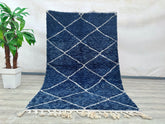How we made our Moroccan Rug?
Handwoven Traditional Moroccan Rugs by Skilled Craftsmen
Moroccan rugs are traditionally made by expert tradesmen with traditions that have been handed down over the centuries These rugs are each a work of art, showcasing the history and culture of Morocco. So, what is a typical Moroccan rug made of?
1. Selection of Wool
This starts with sourcing the best wool available, generally from local farmers. Before being dyed this wool is effectively washed and then treated with natural dyes, usually plants, minerals and sometimes insects. These are natural dyes that provide mop the vibrancy and range regarding hues which might be typically similar to their own attractiveness as well as disorder.
2. Making the Design
The weaver makes the design for the rug after dying the wool. Maximalism Moroccan rugs often feature geometric motifs, symbols or abstract designs to reflect the area's vibrant cultural heritage. These designs are crafted with great precision and are a testament to the weaver's extensive roots to Moroccan craftsmanship.
3. The Loom Setup
The weaver then prepares vertical loom with a rigid frame and two horizontal beams for support. These are the beams that keep the warp threads taut and form the structure of a rug. This loom configuration is essential in order to maintain the structural integrity and longevity of the carpet during weaving.
4. Knotting the Pile
The weaver begins creating the pile of the rug by tying knots in different patterns. They create the border and texture that goes across the surface of the rug by knotting strands of wool onto the warp threads. The knotting process can influence the strength and texture of a rug, denser knots are stronger and create a more textured pile.
5. Weaving the Rows
The weaver takes the wool and, row by row with a needle-like instrument, meticulously weaves it through the warp threads, making sure to follow the pattern as closely as possible. Morocco has many distinctive weaving with each region lending its textile patterns and styles in their own culture resulting in a variety of rug textures and design depths. Note that depending on how it is woven, the final product will be very different.
6. Trimming and Finishing
After the weaving is done, surplus wool pile is trimmed down for a sleeker look. The silky rugs are then subject to further finishing techniques such as brushing, washing or shearing which will give the rug a unique look and texture. All of this is the final bit that makes sure your rug not only looks great but it also feels good to use.
7. Final Touches
The carpet is then finally approved for sales countrywide state after checking quality and tweets. The rug receives a final quality check for any loose threads, then it is signed complete and proud to be displayed in its new home.
Conclusion
Making a Moroccan rug is intensely time-consuming and more lasting up for weeks, months or actually time unit (in the pillowcase of large rugs) bet on the magnitude of the rug and lineament wanted. And while times have changed, to this day most Moroccan rugs made are manufactured by hand using these ancient techniques, resulting in truly unique works of art, reminiscent of generations long past where the textures and colors found in each Morocco rug on your floor will be those that were present a century before.
Enjoy the beauty, workmanship and timelessness of Moroccan rugs and hands no less tradition to your home.
Featured Products
169 x 251 cm = 5.5 x 8.2 ft moroccan wool rug, moroccan style rug, bohemian rug, handmade rug, outdoor patio, beniourain Rug, decor rug, Handmade Gift
- $599.00
$1,830.00- $599.00
- (-67%)
- Unit price
- / per
155 x 247 cm = 5.1 x 8.1 ft Diamonds Blue Soft Dots Berber Runner Rug - Handmade Moroccan Wool, Minimalist Design, Vintage Style, Perfect for Weddings & Bohemian Decor
- $599.00
$1,830.00- $599.00
- (-67%)
- Unit price
- / per
- authentic
- Authentic Moroccan rug
- Beni Rugs
- Beniouraincarpets
- Berber rug history
- bohemian rug moroccan rug
- Custom Area Rug
- Custom Moroccan Rugs
- Handmade carpet
- Handmade rug imperfections
- Luxury home decor
- Modern Beni rugs
- Moroccan heritage
- Moroccan home décor
- Moroccan rug aesthetics
- Moroccan rug authenticity
- Moroccan rug buying guide
- Natural fiber rugs
- Neutral hue rugs
- Rug craftsmanship
- Rug interior alignment
- Rug personalization
- Traditional rug design
- Vintage Moroccan Rug
- white beni ourain
- White wool rug
- Wool Rug










